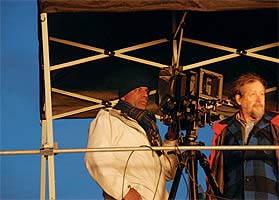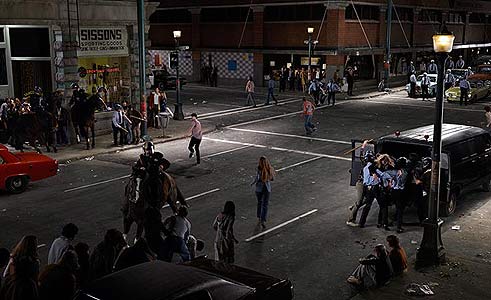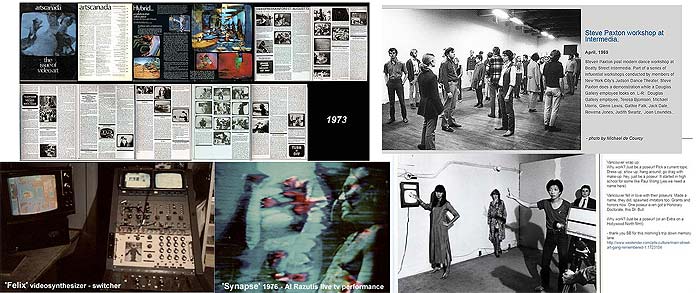'The End of Cinema According to BasketBall Jones*'
by Al Razutis 2022
Quick links:
Take One - Santa Fe Take Two - Abbott & Cordova Take Three - Anthology APPENDICES
TAKE ONE
'END OF CINEMA ACCORDING TO BASKETBALL JONES*'
Screening 'LA Jam' into refrigerator at Santa Fe Art Colony, East L.A., and what led up to it...
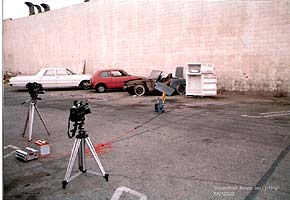
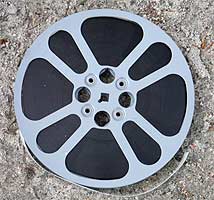
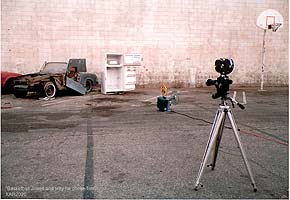
"This is the end, so there is no misunderstanding..."
CUT-OUT FIGURES:

UPLOADING IN PROGRESS!
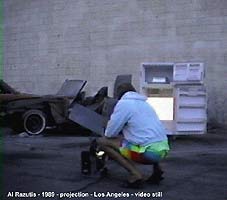
'LA Jam!'
"How do I fit the 405 freeway into a refrigerator and still have space to play some ball?"
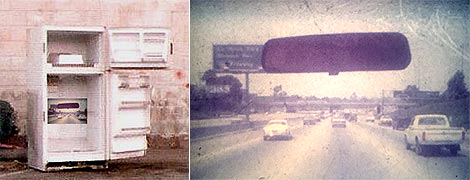
"...and it started like this:"

| "Although Razutis has left Canada, where he lived from 1968 until last year, and has separated himself, at least temporarily, from the avant-garde film scene – he claims to be in Baja, California ‘devoting his (full) attention to surfing’(2) – the Razutis phenomenon remains to be understood and correctly placed in the historical and cultural development of avant-garde art." -- William C. Wees |
"...and like this:"
'KALLING ALL KANADIAN KRITICS' and 'SPLICE'

|
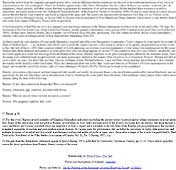
|

|
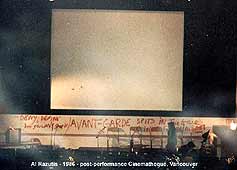
|
|
What the critics said ( >William C. Wees - footnote 18): "For this event, Razutis invited a number of Canadian filmmakers and critics (including the present writer) to attend and/or submit statements on avant-garde film. Some of the statements were included in Razutis' presentation, as were slides showing some of the invitees receiving their invitations. Speaking through a voice modulator and wearing a peaked white cap suggestive of both a wizard and a potentate of the Klu Klux Klan, Razutis put on a performance that mocked, as it imitated, a pastiche of modern and post-modern critical theories. At various pints the performance also included the projection of slides, film projection, and multiple layerings of recorded and live sound: a performance collage not unlike Amerika in many ways. An acerbic critique of the events was published by Bart Testa in the Newsletter of the Film Studies Association of Canada, Vol. 11, No. 3 (Spring 1987), n.p." |
RELATED:
Film performance art by Razutis - 1980's
'THE TILTED X' -- The Professor has no pants!

TAKE TWO
'VANCOUVER CINEMA ACCORDING TO THE SCHOOL OF'
The making & showing of 'Abbott & Cordova 7 August 1971' by Stan Douglas, and what led up to it...
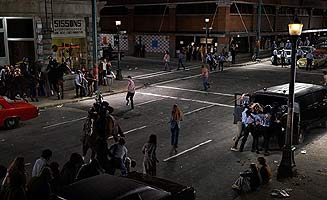
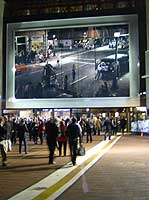
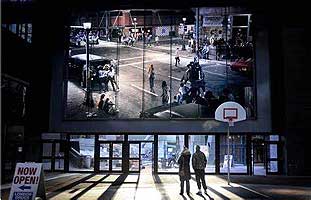
"I used to hate this work, but now I love it, kind of." -- XAR
Installed at Woodward's Centre -- Goldcorp Centre for the Arts, SFU, Vancouver -- with basketball hoop!
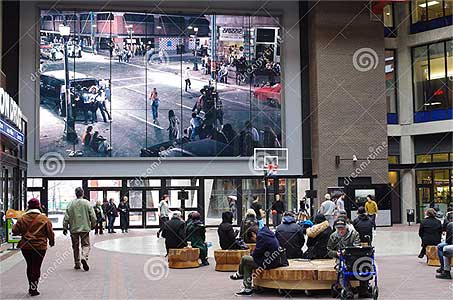
"This is a new beginning, so there is no misunderstanding..."
UPLOADING IN PROGRESS!
'Lights, camera, action!'

"...and it started like this:"
"This work restages the Gastown riot of 1971 and involved more than 100 actors portraying riot police, hippies and Mounted Police. Stan recreated the riot scene by laying down asphalt, reproducing aged building façades and merchandising store windows. The gastown riot of August 7th, 1971 is considered a pivotal moment in Vancouver’s history and a determinant of the neighbourhood’s trajectory for years to come."
( ..... )
"The set was erected with meticulous attention in a parking lot of the Pacific National Exhibition (PNE) in the spring of 2008, and includes details gathered from primary records and through interviews conducted with living participants – police, bystanders and protesters – directly involved in the riot. The set, including a recreated façade of the Woodward’s building, was stocked with detailed period accents, including facsimiles of posters advertising rock concerts on in Vancouver at the time of the riot, and such things as watermelon rinds littering the concrete, that according to testimony, people were eating on the day.
"Given this attention to detail, what is most surprising about the huge finished photograph (thirteen by eight metres), is how it manages to upset our preconceptions about what a riot should look like. Douglas has staged the action so that our gaze is drawn to the image’s edges and away from the relative absence in the photograph’s centre of any “action” (save for two teenagers running in escape from the police). Instead, the confrontations are arrayed around the image’s periphery, where mounted officers barricade groups of youths and riot police and undercover plainclothes cops manhandle others into a paddy wagon. Curious bystanders stand and gawk, apparently comfortable in their perceived risk of arrest, and in the case of two young boys, nonchalantly enjoy the drama from the curbside. Abbott & Cordova, 7 August 1971, contains equal parts violence, voyeurism, fear and confusion, and Douglas has staged the image’s confrontations and spectatorship in a scene where the action appears everywhere and nowhere.
"Through this radical composition, Douglas has created a rupture in our conception of how historical events are, as a genre, portrayed, within a historical counter-narrative of a polarizing civic event. Even prior to its debut the artwork had incited the VPD to publicly condemn Douglas’ choice to recreate the event."
https://westbankcorp.com/public-art/abbott-and-cordova
"This is Douglas’s first public artwork, and the developers volunteered the funding -- between $1 million and $1.5 million, depending on whom you ask. So far, they have thrilled to the piece. "I was very surprised," Douglas says. "I was actually waiting for someone to—I was kind of disappointed that nobody was upset about this project, about this idea. I thought I was being very subversive, and no one's complaining," he adds. "What the hell’s going on?" "
https://thewalrus.ca/at-the-gastown-riot/
Now, whether this is Stan Douglas or another 'Vancouver School' guy like Jeff Wall, the formal strategy seems centered all around ''mise en scene' and re-interpreting history as if it was a 'movie'... not making a movie, but imagining a movie frame... and then making it a 'text to be read' with appropriate citations and notes for curators. Not a movie. End of Cinema. And it commands 'respect' for the mere fact that it 'commands big money', like Jeff Wall's "Dead troops talk" which went for over 3.6 million USD at auction in in NY 2012.
Dead Troops Talk (A Vision After an Ambush of a Red Army Patrol near Moqor, Afghanistan, Winter 1986) -- Jeff Wall, 1992
"One of the most influential photographers to emerge in the last thirty years, Jeff Wall creates elaborately staged transparencies that are displayed in light boxes. Wall’s photographs conjure moments of strange resonance, mixing art historical references with subtle conceptual strategies and juxtapositions to offer a critique of modern living. In Dead Troops Talk, Wall captures an intricate fictional scene that resembles at once a painting of war and a still from a zombie horror film."
-- Broad Foundation
https://www.cbc.ca/news/entertainment/jeff-wall-photograph-sells-for-record-3-6m-us-1.1205822
"In 'Dead Troops Talk', Wall arranged the image with actors in a Burnaby, B.C., studio, photographed in individual sections later assembled digitally, and finally simulated a monumental outdoor photograph."
Precisely a description of intent, process and execution that could be attributed to Stan Douglas' Abbott & Cordova 2009, as described earlier and above.
TAKE THREE
'VANCOUVER ANTHOLOGY' (1991, 2011) Stan Douglas, ed.
and what is missing...

Vancouver Antology is a collection of essays edited by Stan Douglas and based on a number of oral presentations at Or Gallery in 1990 by contributors selected for this publication. The First Edition was printed by TalonBooks in 1991, and the Second Edition was printed in 2011 by the same publisher.
The contents of this book of essays reveals some interesting things about Vancouver and Canadian 'media culture and history'. For example:
- Certain authors and media creators in this book are omitted in favor of a academic curated view that lays heavy emphasis on 'social issues' and 'queer culture' -- the most notable omissions here are the contributions and works of Werner Aellen (Director of Intermedia 1960's) and Al Razutis (Avant-garde and experimental film and video maker, writer, critic, university professor);
- The historical activities of the 1960's in terms of 'film' and 'video' and 'performance' are almost exclusively slanted to those of the 'Western Front and omits the contributions of many non-'Front' individuals, with the exception of 'Video In' and Mike Goldberg who fills the 'social responsibility' role.
- The book completely misunderstands and misrepresents 'underground' 'structural' 'experimental' and 'synaesthetic' cinema and video art, and this misrepresentation is due to Vancouver's flawed and biased histories, in particular that archive collected by 'Michael de Courcy' in his "Vancouver Art in the Sixties" which ignores Intermedia Film Coop, film screenings, and organizations flowing from it almost completely.
Some additional and detailed analysis - background is needed for further reading and will be provided here to show how this 'Take Three' was unsuccessful (except in furthering some people's academic or art careers) and 'botched the subject'.
Sample Essay #1
"Independent Film after Structuralism: Hybred Experimental Narrative and Documentary"
by Maria Insell
|
This essay by Maria Insell competently identifies new trends, a 'new wave' of experimental film, now called 'independent film' and addresses aspects of 'hybrid' techniques and content which are very much a product of 'university classes' or 'academic theories' and academif 'film workshop' (e.g. Simon Fraser University film workshop), and not the popular or local film culture. The people and histories it names as 'new wave' or 'post-structuralist' are primarily film students of those 'structuralist filmmakers' it identifies then wrongly conflates for the sake of argument. The essay totalizes, in a manner of reductive 'branding', that which it calls 'structuralism' or 'structuralist film' to create a straw-man argument which is a rhetorical device of making up opposition for the sake of winning (your argument). It is not convincing in light of real histories mentioned elsewhere. A number of historical errors are featured in this essay, from a misleading categorization of filmmakers David Rimmer, Al Razutis, and others from the 1960's as being "structuralist filmmakers", thereby ignoring a number of important works they did with wildly varied, anti-structuralist, poetic styles and content and diminishing the works as being merely 'formalist' in nature (which is an oversimplification). Another gross error in this essay is to attribute the creation of the Pacific Cinematheque Pacifique to Kirk Tougas and Tony Reif, dating it as '1972', which is in keeping with a bogus history that was peddled for several decades by institutions across Canada. The error in print is not trivial and should be restated here:
For first-hand recollections outlining some destructive faculty conduct affecting SFU film program, see Razutis' 'Black Widows in the Film Studies Web'(2 of 3); and for a definitive account of Razutis' resignation reasons from the SFU film program which he largely created see Letter of Resignation from SFU 1987 .For an updated and corrected view on the creation of the Pacific Cinematheque Pacifique, see this author's web page: Intermedia and Vancouver Organizations and read the names of Werner Aellen, Tony Emery, and read the influence of Al Razutis and the Intermedia Film Coop and weekly underground film screenings dating back to the late 1960's. These were the forerunners of 'PCP' and Aellen and Emery were its chief 'founders', film community and all. Reference: 1967 - Underground Film - Intermedia These errors by Maria Insell, a former film student at Simon Fraser University film workshop and film minor are surprising considering who her instructors were: Al Razutis, David Rimmer, Michael Eliot-Hurst, and later Patricia Gruben. Nowhere in this Insell essay and particularly in paragraphs concerning her own background (pages 313, 317) is "Simon Fraser University Film Program" mentioned. That error of omission is an error of commission, considering that it was Maria Insell herself, a film student, who convinced Al Razutis (the author here) to apply to SFU, then be appointed to a position of professorship in 1978, which he did, and in which he became the head of the film department there, as well as her tutor on film projects to be finished and screened to the community by her. Also not mentioned in this book anywhere is the publication 'Opsis', 'Journal of Avant-Garde and Political Cinema' edited by three SFU Faculty members and containing critical articles and published by Razutis. Because so much of this essay by Insell is about 'structuralism' and 'structuralist cinema' and its abandonment, of particular interest might be Razutis' penned essay contained in Opsis titled 'Propositions for the Deconstruction of Cine-Structuralism' (Razutis, 1985). Another useful Reference concerning Insell's views on cinema is the avant-garde film conference she organized and was commented on: Avant-Garde Film Conference -- 'Splice' by Al Razutis 1986 The timing here is not coincidental. The many links provided here by the author Razutis provides a better context and more details. Maria Insell was a film student at Simon Fraser University only in the late 1970's, meaning she had no direct connection to the film culture in the 1960's or early 1970's at Intermedia. Al Razutis resigned from SFU (Simon Fraser University) in 1987 in protest to the direction the University was taking, and by 1989 he had finished web posting some critical articles of his experiences in Canada and SFU, and that would be several years before the Or Gallery public lectures occurred, which formed the basis of this very book. The editorial 'slant' of this publication is indeed 'curious' because these errors and omissions are not isolated incidents here and appear in other essays in this book. |
Sample Essay #2
"Daring Documents: The Practical Aesthetics of Early Vancouver Video"
by Sara Diamond
|
Another historical essay on 'early Vancouver video' (art and documentation) is by Sara Diamond, a SFU film and communications student and student of Al Razutis (for a while), who certainly was not involved 'in video' in the 1960's - 1970's and came on board later. Thus, all of the 'early history' here is recited from other (second hand) sources. However, Ms Diamond's astute observations pass the test of time. Rather than recite high points of Diamond's selective history -- one with a focus on 'social' and 'gender preference' issues (like queer video and cinema) -- the author here will identify 'what is missing'... Critical absence ( ................ ) TO BE CONTINUED... Useful Reference on Canadian art video from A.R.: 'Watercolour - Abstract' -- the two video arts of Canada by Al Razutis 2013
|
*Appendices
1. 'Who or what is basketball Jones?'
"Basketball Jones is a 1973 animated short film based on the Cheech and Chong song. The cartoon was created to promote the song's release in the United States. It is about a teenager named Tyrone Shoelaces and his love of basketball." --- Bing Search
"While this was happening, the Chicago song "Love Jones" (1972) came on the radio. A nervous Cheech started improvising to the tune, singing, "Basketball Jones, I got a Basketball Jones." --- Bing Search
2. 'No! Not Cheech and Chong in the 70's but earlier! The 60's!'
"
If you're talking the hood, and before shoelaces, that's a dude who won't stop shooting at sunset, and is unbelievably good and passionate about everything about ball. Like that guy skying in the title. Not about color." --- The author
But the Urban Dictionary says: "A Basketball Jones is an obsession with the sport of basketball. Kids who play the game and only think of the world in terms of basketball and their potential success at it."
Last question:
"Is there a relation between Tyrone Shoelaces and Leroy Brown, meaning this song, this game, and the end of 'Amerika', the film by
XAR?"
Last answer:
"Yeah, XAR hung out in East and West LA, did elementary school in South LA, excelled in b-ball and got scholarship to the U, and surfed the beaches not in LA if he could help it. He won a film critics' award for 'Amerika' in West LA which were handed out at one of those Beverly Hills dinners. And then he went back to Baja Mexico to surf. End of LA story."
3. 'Why is this taking so long?'
"Because we are now in overtime. This game is not over!"
4. 'Why is queer culture and queer cinema an issue here?'
"The notion that "You can't be avant-garde if you are not queer, Al." was foisted on the author (Razutis) by a curator and critic of this 'new school of Vancouver media', by the name of Amy Fung in 2012. This idea is completely rejected here in this essay because the author's (Razutis) experience was that in the 1960's - 1970's the 'underground film' or 'experimental film' (otherwise known as 'avant-garde film' in North America) was completely independent of 'gender preference', or whether one was 'straight' or 'gay' when making films, or writing about them. There was no segregation, no privileging. The 1960's featured many prominent 'gay' filmmakers: Andy Warhol, Kenneth Anger, Will Hindle, and many others among them. This idea about segregation, privilege, or special status 'if you are gay' is nonsense and a 1980's invention. It is mentioned here because this idea became a hallmark of 'Vancouver Media Culture' in the 80's to the present."
5. 'Why are there so many hyperlinks and references in TAKE THREE, the book ANTHOLOGY?'
"When we get to 'academic writing' we get to the 'library', with everyone making reference, quoting sources, showing off the book stacks and obligatory readings. That's one of the ways 'film culture in Canada' functioned in the last decades of the past century."
[FILMS AND VIDEOS] [3D VIDEO] [HOLOGRAPHY]
